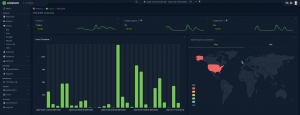Microsoft365 and Unified SOC Integration

SUSPICIOUS ACCESS
IDENTIFICATION

BEHAVIOR AND PRIVILEGE
ISOLATION

ACCOUNT
ISOLATION

MANAGED SOC

MALICIOUS MAIL
FORWARDING CHANGES
 HARDENING GUIDANCE
HARDENING GUIDANCE
 Safeguard your cloud environment against cyber threats with Léargas' early intervention. In the realm of cloud-based systems, a single hijacked credential or breached account can initiate a devastating cyberattack. By monitoring user behavior and identifying early signs of foul play, such as unauthorized entries or email tampering, you can swiftly counteract an emerging threat, potentially averting significant harm. Utilize Léargas' Managed Detection and Response (MDR) for Microsoft 365 to detect and address early indicators of cyber threats, effectively outpacing hackers.
Safeguard your cloud environment against cyber threats with Léargas' early intervention. In the realm of cloud-based systems, a single hijacked credential or breached account can initiate a devastating cyberattack. By monitoring user behavior and identifying early signs of foul play, such as unauthorized entries or email tampering, you can swiftly counteract an emerging threat, potentially averting significant harm. Utilize Léargas' Managed Detection and Response (MDR) for Microsoft 365 to detect and address early indicators of cyber threats, effectively outpacing hackers.
Provide your cloud with the continuous protection it needs, operating around the clock. Léargas MDR for Microsoft 365 fortifies your Microsoft 365 users, applications, and environment, backed by the nonstop vigilance of the Léargas Security Operations Center (SOC). Our SOC experts analyze threat detections, offering detailed incident reports and practical solutions for recovery. Every alert is scrutinized by a Léargas specialist, ensuring only relevant reports are escalated when suspicious activities are detected. This MDR service guarantees uninterrupted protection for your Microsoft 365, covering all times, including peak seasons, off-hours, and holidays.
Reclaim valuable time and enhance your long-term security strategy. MDR for Microsoft 365 integrates seamlessly with your Microsoft Cloud setup, harvesting data from users, tenants, and applications. This data is augmented with both internal and external threat intelligence, providing insights like geolocation and IP reputation. The Léargas SOC leverages this enriched data to deliver highly accurate incident reports and optimal solutions for rapidly neutralizing cyber threats.
Partial List of Features and Detected Threats:
- Consent to Install New Applications: Plays a crucial role in maintaining the integrity of application permissions, ensuring that only authorized and intended consents are processed. This helps in safeguarding the system from unauthorized application access and potential security breaches.
- New Inbox Rules: This functionality is key in preventing malicious activities like email forwarding or deletion rules that might be set up by threat actors post-compromise.
- Account Additions and Removals: Essential for monitoring and logging any new user additions, ensuring that all new user accounts are legitimate and authorized, thereby maintaining the security and integrity of the user base.
- User Submission Alerts: Designed to trigger alerts for specific actions excluding user submissions. This differentiation ensures that alerts are focused on system-initiated actions rather than user-reported submissions, streamlining the alert process and focusing on system-level security incidents.
- Geography-Based and ITAR Violation Notifications: Particularly useful for organizations that want to closely monitor international access and activities, or for those operating mainly within the U.S. and looking to flag foreign access.
- Multi-Factor Authentication Failures: Key in identifying instances where a user fails to complete the 2FA process, a potential indicator of unauthorized access attempts.
- Malicious Link Clicks: Particularly effective in identifying and responding to security threats that involve malicious URLs, ensuring rapid detection and response to potential cyber threats.
